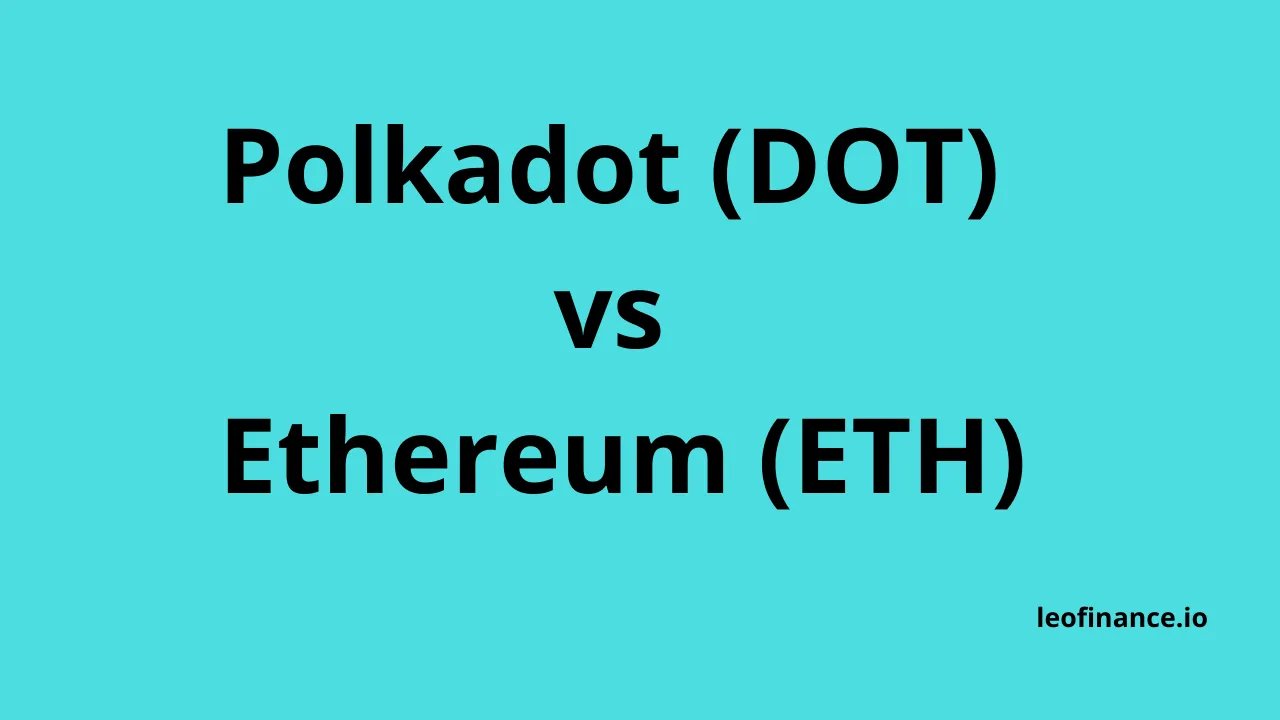
This section is a part of Polkadot Guide. In this section we are going to compare two blockchains - Polkadot (DOT) and Ethereum (ETH).
Introduction
This guide is meant to show you unbiased feature set comparison of blockchains in discussion. Below table shows you the comparison points between the two blockchains.
| Polkadot (DOT) | Ethereum (ETH) |
| Polkadot project started in 2016 while the Mainnet release was in 26th May 2020. | Ethereum was released in 30th July 2015 while it's project and whitepaper appeared in 2013. |
| Polkadot has a total supply of 1.11 Billion and circulating supply of 1 Billion DOT as of now. | Ethereum has a $365,186,415,050 total number of coins while 117,046,619 coins in circulation. |
| Polkadot makes use of the Nominated Proof of Stake (BABE/GRANDPA) consensus algorithm on it's network. | Ethereum initially was deployed with Proof of Work mining consensus but recent update has Proof of Stake consensus (Casper) algorithm which would be future of the network. |
| Polkadot relay chain does not support the smart contracts however the parachains support the smart contracts. | Ethereum blockchain on it's all layers support the smart contracts through Ethereum Virtual Machine. |
| Polkadot has support for NFT, dApps and DeFi applications on both it's relay chain and the parachains. | Ethereum from it's inception supported dApps, tokens, DeFi and the infrastructure for the NFTs. |
| Polkadot has Parachains feature that allows other blockchains to become bridge and governance under the Polkadot relay chain. | Ethereum has layer 2 solutions for extending it's blockchain for additional features which includes bridge, DeFi and other use case scenario. |
| Polkadot makes use of the Rust programming language for it's chain language. | Ethereum makes use of Solidity as it's primary language for building smart contracts and dApps. |
| Polkadot has off-chain community governance and the web3 no longer has centralized control any more. It is decentralized and permissionless. | Ethereum 2.0 now has a decentralized community off chain governance which includes users, node owners, developers and the miners. |
| Polkadot has it's own parachain features for the interoperability which allows it to connect with external chains. It's easy to build cross chain bridges to connect multiple chains to the relay chain or the parachains. | Ethereum requires external solutions build to connect the bridge with it's EVM for cross chain interoperability. It allows support for validators, oracles and the bridge converters. |
| Polkadot mainnet testing has recorded around 1000 TPS speed. It is designed to scale as per the requirement and load. | Ethereum currently has a TPS of 15 to 30. It is expected to change once the ETH 2.0 deployment is completed. |
| Polkadot has staking reward from 7% which can go upto 12% and current it is available in DOT supported marketplace and exchanges. | thereum current staking rewards are from 5% and can be staked through most of the exchanges or marketplaces. |
| Polkadot has multiple heterogeneous parachains in it's working environment. | Ethereum has Multiple homogenous shards in it's working environment. |
| Polkadot offer chain security through shared pool model. It also makes use of the auctions to weed out the suspicious parties making use of it's blockchain. This was there wont' be 51% type of attacks on the chain infrastructure. | Ethereum makes use of permissionless and immutable security governance which clears most of the security issues in the chain. Despite this ETH network suffered 51% attack on it's network. |
| Polkadot blockchain was designed to solve the issues of speed and the congestion. It's parachains were designed to solve the congestion issue as it has it's own mini chains that connect to relay. | Ethereum blockchain intends to solve the security, privacy and decentralized blockchain issues along with the ability to develop dApps and external projects on it's chain. |
Polkadot (DOT) or Ethereum (ETH)?
Each blockchain solves a different problem set in the crypto industry.
Ethereum was designed for the smart contracts and distributed finance (DeFi), which is now facing the scalability issues due to it's previous consensus algorithm which involved mining.
Polkadot on the other hand makes use of single relay chain which contains parachains that have their own governance and interoperability ecosystem. It makes use of the auctions for parachain slots. This solves the congestion and the speed issues on it's blockchain.
Conclusion
For an investor the investment depends on the usecase and the market adoption of those blockchains. For developers both these chains offer opportunity to address various pain-point use cases in the blockchain industry.
Both of these blockchains are capable of doing each others tasks through 3rd party projects being built on them to address missing features. Yet scalability, speed and the market adoption separates their use cases. So this is more of Polkadot and Ethereum scenario instead of one or the other scenario.
